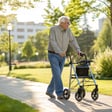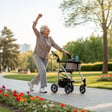Aging brings challenges, but the right tools can help maintain independence and quality of life.
Understanding Mobility Aids for Seniors
As we age, simple daily activities can become increasingly difficult. Reduced mobility, strength, and balance can turn routine tasks into frustrating challenges. Fortunately, a variety of small mobility aids for seniors can make a significant difference in maintaining independence and quality of life.
These devices aren't just about moving from place to place—they're about preserving dignity and enabling seniors to continue participating in the activities they enjoy. According to the National Institute on Aging, most older adults prefer to "age in place," remaining in their own homes as long as possible, and appropriate mobility aids can make this goal more achievable.
Common Small Mobility Aids for Daily Use
Walking Assistance Devices
Walking aids provide stability and confidence for seniors with balance or strength issues. These range from simple to more supportive options:
- Canes: The simplest walking aid, providing light support for those with minor balance issues or weakness on one side
- Walking sticks: Similar to canes but often designed for outdoor use
- Folding canes: Convenient for storage and travel
- Quad canes: Featuring four feet for greater stability
- Walking poles: Used in pairs, these provide balance while encouraging upper body engagement
For those needing more substantial support, walkers and rollators offer additional stability. Modern designs include lightweight frames, comfortable handgrips, and convenient storage options.
Bathroom Safety Aids
The bathroom can be particularly hazardous for seniors with mobility challenges. Slippery surfaces and the need to transition between sitting and standing make falls more likely. Small aids that make a big difference include:
- Grab bars near toilets and in showers
- Raised toilet seats
- Shower chairs or benches
- Non-slip mats
- Hand-held shower heads
- Long-handled sponges for bathing
These modest additions can dramatically reduce fall risk while maintaining privacy and independence in personal care routines.
Kitchen Mobility Aids for Seniors
The kitchen often presents unique challenges for older adults with mobility or strength limitations. Reaching, gripping, and standing for food preparation can become difficult. Fortunately, several small aids can make kitchen tasks more manageable:

Food Preparation Helpers
- Jar openers and bottle openers with leverage handles
- Cutting boards with food guards and knife handles
- Lightweight kettles with tipping mechanisms
- Easy-grip utensils with cushioned handles
- Perching stools for reducing standing time
One of my neighbors recently mentioned how a simple jar opener completely changed her ability to prepare meals independently. These small tools preserve autonomy in nutrition and meal preparation—a crucial aspect of maintaining health and enjoyment in daily life.
Bedroom and Dressing Aids
Getting dressed and managing bedroom activities can become challenging with reduced flexibility and strength. Several small aids can help:
- Dressing sticks for reaching clothing
- Button hooks and zipper pulls
- Long-handled shoe horns
- Sock aids for putting on socks without bending
- Bed rails for assistance getting in and out of bed
- Reacher-grabbers for retrieving dropped items
Musculoskeletal Health Australia notes that these simple devices can significantly reduce strain and frustration during daily dressing routines.
How Do I Choose the Right Mobility Aids?
Selecting appropriate mobility aids can feel overwhelming with so many options available. Consider these factors when making choices:
- Assess specific needs - Identify which daily activities present the greatest challenges
- Consult healthcare professionals - Occupational therapists can provide personalized recommendations based on individual capabilities
- Try before buying - When possible, test devices to ensure comfort and usability
- Consider living environment - Ensure aids will work within the home's layout and space constraints
- Plan for changing needs - Select adjustable options when possible to accommodate changing abilities
The NHS recommends requesting a home assessment from local social services to receive personalized recommendations for household equipment and adaptations that can make life easier.
Funding and Resources for Mobility Aids
Cost shouldn't prevent seniors from accessing helpful mobility aids. Several resources can help offset expenses:
- Medicare may cover some mobility aids when prescribed by a physician
- Area Agencies on Aging often provide information about local resources
- Veterans benefits may include coverage for mobility equipment
- Some charitable organizations offer financial assistance or donated equipment
- Local senior centers frequently know about community-specific resources
The Wright Stuff, a provider of daily living aids, suggests checking with insurance providers about coverage options before making purchases.
Beyond Physical Aids: Tech Solutions
While traditional mobility aids remain essential, technology is creating new possibilities for senior independence:
- Voice-activated home systems for controlling lights and appliances
- Medication reminder apps and devices
- GPS-enabled devices for those who wander
- Video doorbells for screening visitors without walking to the door
- Smart watches with fall detection and emergency response features
These technological solutions complement physical mobility aids, creating comprehensive support systems for aging in place.
Maintaining Dignity While Using Mobility Aids
Many seniors resist using mobility aids due to concerns about appearance or perceived loss of independence. However, the right approach can help overcome this resistance:
- Focus on how aids enable continued activity and independence
- Select stylish, modern designs when available
- Introduce aids gradually, starting with those addressing the greatest needs
- Emphasize that using appropriate aids can prevent falls and injuries that would further limit independence
Remember that mobility aids are tools for empowerment, not symbols of limitation.
Disclaimer: This information is provided for educational purposes only and is not a substitute for professional medical advice. Always consult healthcare providers regarding mobility needs and appropriate assistive devices.
Tags

About Evelyn Grant the Author
Evelyn Grant is a trailblazer in the world of cycling fashion, known for combining functionality with style. With over a decade of experience, she designs apparel that meets the demands of avid cyclists while making a bold fashion statement.
Recommended Articles
4 Everyday Drinks Being Studied for Circulation Support
Explore 4 everyday drinks that may enhance circulation, including herbal teas, coffee, red wine, and beetroot juice. Discover their health benefits.
Why More Seniors Are Considering Compact Mobility Tech
Explore how compact mobility tech enhances independence and quality of life for seniors, making daily activities more accessible and enjoyable.
Why More Seniors Are Replacing Walkers With This Sleek Device
Discover why seniors are opting for sleek mobility devices over traditional walkers, enhancing their independence with style and functionality.
2025 Cadillac CT4 Combines Performance With Refined Luxury
Discover the 2025 Cadillac CT4, where thrilling performance meets luxury, featuring advanced safety, elegant interiors and powerful engine options.
2025 Lexus RX Keeps the Luxury SUV Crown With Smarter Features
The 2025 Lexus RX redefines luxury SUVs with advanced tech, safety features, and a focus on comfort for an unparalleled driving experience.




